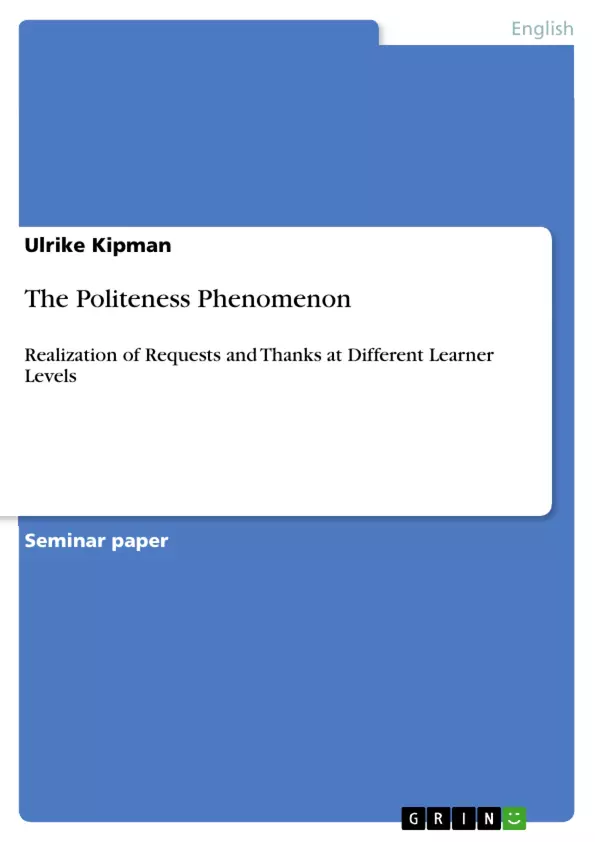The term “politeness” goes back to the sixteenth century (e.g. Burke 1993) and is described as “having or showing that one has good manners and consideration for other people” in the Oxford Advanced Learners Dictionary. However, since it is associated to the terms “civility” and “courtesy”, there are several connections to civilization and life-experience (see for example the Dutch translation “be-leefd-heid”). Therefore “politeness” is not an absolute term, but influenced by social hirarchy and social status. For about 30 years by now politeness is a very popular research topic and the term has received many different definitions and interpretations (Eelen, 2001). I therefore want to start by summarizing and discussing the most important approaches to linguistic politeness.
One of the most interesting aspects of this research field is its situation in the intersection of language and social reality. To study linguistic politeness may lead to a deeper understanding of the connections between society, ethics and language. In the linguistic perspective politeness is a form of language use, which is therefore invariably coupled with social roles and relationships.
Not only the social state in a given speech community, but also the language itself influences the expression of politeness, since speech communities differ in their notion of politeness. In second language acquisition not only vocabulary and grammar rules have to be learnt, but also the set of social norms of the foreign speech community. It is therefore of great interest, how second language learners show politeness at different learner levels. I will present an empirical study on the expression of Request and Thanks in Austrian students of different English competence level compared to a native speaking control group.
Inhaltsverzeichnis (Table of Contents)
- Introduction
- State of the Art
- Politeness Theories
- The social norm
- The conversational maxim
- \"face saving\"
- The conversational contract
- The boomerang model
- Characterization of Requests and Thanks
- Politeness Theories
- The research problem
- Method
- Design
- Data
- Subjects
- The results
- Description of results
- Discussion
- Conclusion
- References
Zielsetzung und Themenschwerpunkte (Objectives and Key Themes)
The main objective of this work is to investigate the expression of requests and thanks at different learner levels of English as a second language (ESL). The study focuses on Austrian students of English and compares their usage of these speech acts with a native speaker control group.
- The role of politeness in language and social interaction
- Different theories of linguistic politeness and their application to requests and thanks
- The impact of learner level on the realization of politeness strategies
- Cross-cultural variations in politeness norms
- The relationship between language and social reality in the context of politeness
Zusammenfassung der Kapitel (Chapter Summaries)
- Introduction: This chapter provides an overview of the concept of politeness, tracing its historical roots and highlighting its evolving interpretations. The author emphasizes the connection between politeness, social hierarchy, and language use, setting the stage for the empirical investigation that follows.
- State of the Art: This chapter reviews prominent theories of politeness, particularly those proposed by Fraser (1990) and Held (1995). The chapter delves into key concepts such as the social norm, the conversational maxim, "face saving," and the conversational contract. It also introduces the specific speech acts of requests and thanks, which will be the focus of the empirical study.
- The research problem: This chapter outlines the research question driving the study. The author addresses the significance of examining how second language learners utilize politeness strategies at different levels of competence.
- Method: This chapter details the design, data collection, and participant selection of the empirical study. It provides information on the research methodology, data sources, and the subjects involved.
- The results: This chapter presents the findings of the study, highlighting key patterns and observations. The results are likely to provide insights into the different ways in which ESL learners and native speakers express requests and thanks.
Schlüsselwörter (Keywords)
This study explores the concept of linguistic politeness, focusing on the realization of requests and thanks in different learner levels of English. Key themes include politeness theories, speech acts, social norms, second language acquisition, cross-cultural communication, and empirical research methods.
- Arbeit zitieren
- MMag. DDr. B.Sc. Ulrike Kipman (Autor:in), 2009, The Politeness Phenomenon, München, GRIN Verlag, https://www.hausarbeiten.de/document/157383


